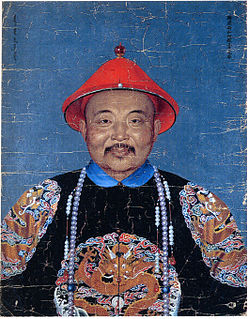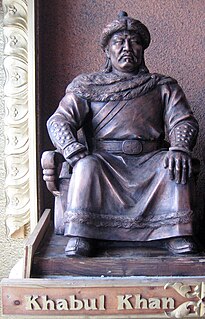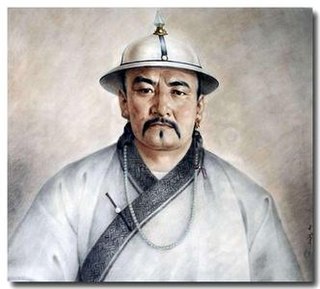 W
WThe following is a list of Mongol rulers.
 W
WAmbaghai or Hambaqai Khan was a khan of Khamag Mongol, one of the great grandsons of Khaidu Khan and the cousin and predecessor of Hotula Khan.
 W
WDawachi was the last khan of the Dzungar Khanate from 1753 until his defeat at the hands of Qing and Mongol forces at Ili in 1755.
 W
WDelbeg was the Mongol Khan of the Northern Yuan dynasty based in the Mongolian Plateau. The Oirats finally installed the young Delbeg in 1412 as their puppet Mongol Khan, but this was not recognized by most of Mongol clans in the central and eastern Mongol territories.
 W
WJamukha was a Mongol military and political leader and the chief rival to Temüjin in the unification of the Mongol tribes.
 W
WBarsbolad Jinong Khan or Barsbolad Khan ; Chinese: 巴爾斯博羅特; 1490–1531) was a Mongol Khagan of the Northern Yuan dynasty based in the Mongolian Plateau from 1517 to 1519, and Jinong, from 1519 to 1531.
 W
WJochi was a Mongolian army commander who was the eldest son of Genghis Khan, and presumably one of the four sons by his principal wife Börte, though issues concerning his paternity followed him throughout his life. An accomplished military leader, he participated in his father's conquest of Central Asia, along with his brothers and uncles.
 W
WKhabul Khan, also known as Qabul Khan, Kabul Khan and Khabul Khagan, was the first known Khan of the Khamag Mongol confederation and great-grandfather of Genghis Khan.
 W
WAdai was the Mongol Khan of the Northern Yuan dynasty based in the Mongolian Plateau. After the prominent eastern Mongolian chancellor, Arughtai, threw his allegiance to him, he briefly reunited most of the Mongols under his banner.
 W
WDayan Khan was a Mongol khan who reunited the Mongols under Chinggisid supremacy in the Northern Yuan dynasty based in the Mongolian Plateau. His reigning title, "Dayan", means the "Great Yuan", as he enthroned himself as Great Khan of the Great Yuan, though the Yuan dynasty, the principal khanate of the Mongol Empire, had already lost control over China proper a century earlier (1368).
 W
WChoros Erdeniin Galdan was a Dzungar-Oirat Khan of the Dzungar Khanate. As fourth son of Erdeni Batur, founder of the Dzungar Khanate, Galdan was a descendant of Esen Taishi, the powerful Oirat Khan of the Northern Yuan dynasty who united the western Mongols in the 15th century. Galdan's mother Yum Aga was a daughter of Güshi Khan, the first Khoshut-Oirat King of Tibet.
 W
WLigdan Khutugtu Khan or Lindan Han (林丹汗) was the last khan of the Northern Yuan dynasty based in the Mongolian Plateau as well as the last in the Borjigin clan of Mongol Khans who ruled the Mongols from Chakhar. His unpopular reign generated violent opposition due to his harsh restrictions over the Mongols. His alliance with Ming dynasty of China, sponsorship of Tibetan Buddhism in Chakhar and reorganization of Mongolian political divisions were ineffective when the Qing dynasty became the major power in East Asia.
 W
WManduul Khan , was the Mongol Khan of the Northern Yuan dynasty based in the Mongolian Plateau, and he was the younger half-brother of Taisun Khan.
 W
WKhatun means Queen, Emperor's consort and high-ranking noblewoman in Mongolian. They were very influential at the ordo (palace) of the Mongol regimes in various times.
 W
WMandukhai Khatun (Mongolian: Мандухай хатан, Chinese: 滿都海哈屯, also known as Mandukhai Sechen Khatun, was a Khatun of the Northern Yuan dynasty based in the Mongolian Plateau. With her second husband Batmunkh Dayan Khan, she helped reunite the warring Mongols.
 W
WMolon Khan was a Khan of the Mongol Northern Yuan dynasty based in the Mongolian Plateau. He was the eldest son of Taisun Khan.
 W
WTserendondovyn Navaanneren was the 20th Khan of the hereditary Setsen Khanate located in the eastern third of modern-day Mongolia. His full title was "Mahasamadi Dalai Setsen Khan". The first Setsen Khan was Sholoi (1577–1655) of the Khalkha, who was a direct descendant of Genghis Khan through Batumongke Dayan Khan (1464–1543).
 W
WThe Ordos are a Mongol subgroup that live in Uxin Banner, Inner Mongolia of China. Ordos literally means plural of Ordo.
 W
WÖrüg Temür or Gulichi was a Mongol leader who temporarily enthroned himself Khan of the Northern Yuan dynasty based in the Mongolian Plateau in the early 15th century. He might also have been known as Ugechi Khashikha. "Khashikha" means prince or duke in the Tungusic languages. He was a leader of the Oirats, particularly the Torguud clan. Örüg Temür may have been descended from either Ariq Böke or Genghis Khan's younger brothers, either Hasar or Temüge. He may also have been a descendant of Ogedai. Thus, it is still unclear whether he was an Oirat or Genghisid.
 W
WMuhammad Shaybani Khan, was an Uzbek leader who consolidated various Uzbek tribes and laid the foundations for their ascendance in Transoxiana and the establishment of the Khanate of Bukhara. He was a Shaybanid or descendant of Shiban, the fifth son of Jochi, Genghis Khan's eldest son. His father was Sheikh Haidar, son of Abu'l-Khayr Khan.
 W
WThe Shaybanids were a Persianized Turko-Mongol dynasty in Central Asia. They were the patrilineal descendants of Shiban, the fifth son of Jochi and grandson of Genghis Khan. Until the mid-14th century, they acknowledged the authority of the descendants of Shiban's brothers Batu Khan and Orda Khan, such as Öz Beg Khan. The Shaybanids originally led the grey horde southeast of the Urals, and converted to Islam in 1282. At its height, the khanate included parts of modern-day Afghanistan and other parts of Central Asia.
 W
WTolui (c.1191–1232) was the fourth son of Genghis Khan by his chief khatun Börte. His ulus, or territorial inheritance, at his father's death in 1227 was the homelands in Mongolia, and he also served as civil administrator until 1229, the time it took to confirm Ögedei as second Great Khan of the Mongol Empire (1206–1368). Before that he had served with distinction in the campaigns against the Jin dynasty, the Western Xia and the Khwarezmid Empire, where he was instrumental in the capture and massacre at Merv and Nishapur. He is a direct ancestor of most of the Ilkhanids.
 W
WTöregene Khatun was the Great Khatun and regent of the Mongol Empire from the death of her husband Ögedei Khan in 1241 until the election of her eldest son Güyük Khan in 1246.
 W
WTümen Zasagt Khan was a 16th-century Mongol Khagan of the Northern Yuan dynasty based in the Mongolian Plateau who reigned from 1558 to 1592. He was the successor of Darayisung Gödeng Khan and had direct rule over the Chahar. It was during his rule that the Mongols conquered Daur and Evenks. Unlike his father, he succeeded in uniting the entire Mongol people, including the Western Mongols, with little bloodshed.
 W
WThe Uzbek Khanate of the Abulkhairids was the Shaybanid state preceding the Shaybanid Empire of Muhammad Shaybani and the Khanate of Bukhara. During the few years it existed it was the preeminent state in Central Asia. This is the first state of the Abulkhairids, a branch of the Shaybanids.